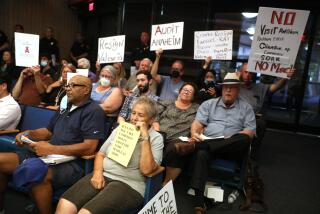PERSPECTIVE ON CAMPAIGN REFORM : Rules Change but Game’s the Same : Behind the back-room smoke and double talk, the Democrats will be doing business as usual with PACs.
- Share via
When, with great fanfare, President Clinton and Democratic congressional leaders unveiled their long-awaited campaign finance reform proposal earlier this month, the President described it as a historic occasion: “This plan will change the way Washington works, the way campaigns are financed, the way politics is played.”
Standing beside the President, Senate Majority Leader George Mitchell underscored its importance: “The American people no longer have confidence in the political process. They believe powerful special interests and wealthy individuals control the political system and prevent government from serving the people. We must and we can change that.” House Speaker Tom Foley expressed confidence their bill would do just that: “This is a bright day in American politics.”
Behind this rhetoric, however, is the reality of a political compromise, the product of protracted, intense negotiations between the White House and the Democratic congressional leadership that delayed its introduction for months. By all accounts, it was the House leaders who held things up as they insisted on terms to their liking.
What most Americans outside of Washington do not know is just how perverse a product emerged from this process. It is shocking how precisely the House leaders shaped the bill to fit present incumbent fund-raising practices and to perpetuate incumbent financial advantages.
This becomes clear if we compare the financial limits proposed with current congressional practice.
* Campaign spending limits : The limit for House candidates would be $600,000, with up to $60,000 in fund-raising expenses exempted.
In a study of 1990 election spending, Times reporters Sara Fritz and Dwight Morris found that on average House incumbents spent $390,000. Those in close races averaged $557,000. To raise the funds, incumbents invested an average of $69,000. So, the cap remarkably fits incumbent practice.
To call this spending limit real reform is like saying that a bartender who announces a 10-drink limit is effectively curbing drunkenness.
* PAC contribution caps: The maximum amount a PAC could contribute to a House candidate would be $5,000 per election, and each candidate could solicit no more than a total of $200,000 from PACs. The President called the $200,000 limit “a dramatic change in the present system.”
Although Clinton pledged in his campaign to reduce the maximum PAC contribution to $1,000 per election, his negotiations with House leaders stalled until he agreed to keep the current figure, $5,000. As for the “dramatic change,” the $200,000 limit turns out to be a bit less than dramatic if you realize that in 1990, House incumbents averaged about that amount in PAC contributions, $209,000. Once again, the proposal was shaped to conform to current incumbent practice.
* Matching public funds: The first $200 of any individual’s or PAC’s donation to a qualifying House candidate would be matched in communications vouchers for broadcast, print and mail expenses, up to a maximum of $200,000.
The problem here is that incumbents will have no trouble taking advantage of the full $200,000 bonanza, whereas challengers will rarely be able to do so. In 1990, major party challengers who made it to the general election raised an average of only $111,000. So, challengers would tend to fall far short of the full matching amount. It will be incumbents who benefit the most.
In one way, the Senate provisions are better, with spending limits below present practice in many states. But there is also a major deception in the anticipated Senate bill. In the proposal negotiated with the White House, PACs could give a Senate candidate up to $2,500 per election. But when Senate Republicans threatened an amendment banning PAC contributions, which many Democrats would be afraid to vote against, the Democrats decided to preempt and include a PAC contribution ban in their bill. Their little secret, well known in Washington, but not to the American people, is that they intend to restore the $2,500 in PAC contributions to Senate candidates as a “compromise” at the very end in the House-Senate conference.
However, in its present form, the proposal would not much change either the way Washington works or the way American politics is played. The big-money links between incumbents and special-interest lobbying coalitions would remain. And nothing approaching a level financial playing field for incumbents and challengers would result.
From their rhetoric, it is clear that Democratic leaders understand what is troubling the electorate about money and politics. But, as the President noted in a moment of candor, “Campaign finance reform is a tough issue . . . It requires those of us who set the rules to change the rules that got us all here. That’s not easy to do.” They need a reminder from all of us that we sent them there to give us real change, not just more rhetoric.
More to Read
Get the L.A. Times Politics newsletter
Deeply reported insights into legislation, politics and policy from Sacramento, Washington and beyond. In your inbox twice per week.
You may occasionally receive promotional content from the Los Angeles Times.










